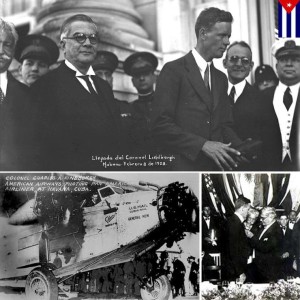CHARLES LINDBERGH AND “THE SPIRIT OF ST. LOUIS” IN HAVANA.
On February 8, 1928, in goodwill flight, from Haiti, aviation hero Charles A. Lindbergh, controls the famous “Spirit of St. Louis” arrives at Havana and declared this day as “THE DAY OF LINDBERGH”; while agreeing with the Conference of Foreign Ministers of Havana. That day began a few days of tributes and celebrations in his honor, and was hailed by our people in the North Terrace of the Palace, decorated by the President and guest of honor numerous cultural and scientific institutions.
On February 12, 1928, Lindbergh invited President Gerardo Machado to fly over Havana using a three-engine Pan American Airways transported daily correspondence between Key West and Havana. The aircraft had 12 seats and was prepared and adorned to welcome the Cuban president, one of the first rulers in flying.
The next day the pilot departed for their country. In the fuselage of his plane had painted the Cuban flag next to others that remembered the countries he had visited.
After his historic flight across the Atlantic, Lindbergh visited many countries in his plane and as a souvenir of their visit, the flag of these countries in the fuselage was painted.
The Cuban flag is the last because after this trip, Lindbergh withdrew his plane “Spirit of St. Louis” and donated it to the Smithsonian Institute, for their conservation, April 30, 1928.
The Spirit of St. Louis is currently on display at the Musée de l’Air, Washington, DC, USA. UU.
The aircraft was manufactured in San Diego, California. The industrialists who funded the transatlantic flight were men of Saint Louis, Missouri, which was given the plane the name of that city. Lindbergh participated in the design and construction of the apparatus, model Ryan NYP (a development of the above Ryan M-1 / M-2), with a draft Donald Hall. In just two months he had finished making the Spirit of St. Louis. It was an airplane with wings on high, with wooden structure. Was fuselage steel pipes, and siding material was.
MemoriasDeCuba / Derubín Jacomé / InternetPhotos / www.thecubanhistory.com
The Cuban History, Hollywood.
Arnoldo Varona, Editor.
CHARLES LINDBERGH Y “EL SPIRIT OF ST. LOUIS” EN LA HABANA.
El 8 de febrero de 1928, en vuelo de buena voluntad, procedente de Haití, el héroe de la aviación, Charles A. Lindbergh, a los controles del famoso “Spirit of St. Louis” llega a la capital cubana y se declara este día como “EL DIA DE LINDBERGH”; al mismo tiempo coincidiendo con la Conferencia de Cancilleres de La Habana. Ese día
comenzaron unas jornadas de homenajes y festejos en su honor, siendo aclamado por nuestro pueblo en la Terraza Norte del Palacio, condecorado por el Presidente e invitado de honor de numerosas instituciones culturales y científicas.
El 12 de febrero de 1928, Lindbergh invitó al presidente Gerardo Machado a sobrevolar La Habana utilizando un trimotor de la Pan American Airways que diariamente transportaba la correspondencia entre Cayo Hueso y La Habana. La aeronave contaba con 12 asientos y fue preparada y engalanada para acoger al mandatario cubano, uno de los primeros gobernantes en volar en avión.
Al día siguiente el piloto partió para su país. En el fuselaje de su avión había pintado la bandera cubana junto a otras que recordaban los países que había visitado.
Después de su histórico vuelo sobre el Atlántico, Lindbergh visitó muchos países en su avión y como recuerdo de sus visitas, se pintaba la bandera de estos países en el fuselaje.
La bandera cubana es la última porque después de este viaje, Lindbergh retiró su avión “Spirit of St. Louis” y lo donó al Instituto al Smithsonian, para su conservación, el 30 de abril de 1928.
El Spirit of St. Louis se encuentra actualmente expuesto en el Museo del Aire y del Espacio, Washington, DC, EE. UU.
El avión fue fabricado en San Diego, California. Los industriales que financiaron el vuelo transatlántico eran hombres de Saint Louis,Misuri, por lo que se le dio al avión el nombre de esa ciudad. Lindbergh participó en el diseño y en la construcción del aparato, modelo Ryan NYP (un desarrollo de los anteriores Ryan M-1/M-2), siendo un proyecto de Donald Hall. En sólo dos meses había terminado la fabricación del Spirit of St. Louis. Se trataba de un avión con alas de implantación alta, con estructura de madera. El fuselaje era de tubos de acero, y el revestimiento exterior era de tela.
MemoriasDeCuba/Derubin Jacomé/InternetPhotos/www.thecubanhistory.com
The Cuban History, Hollywood.
Arnoldo Varona, Editor.





